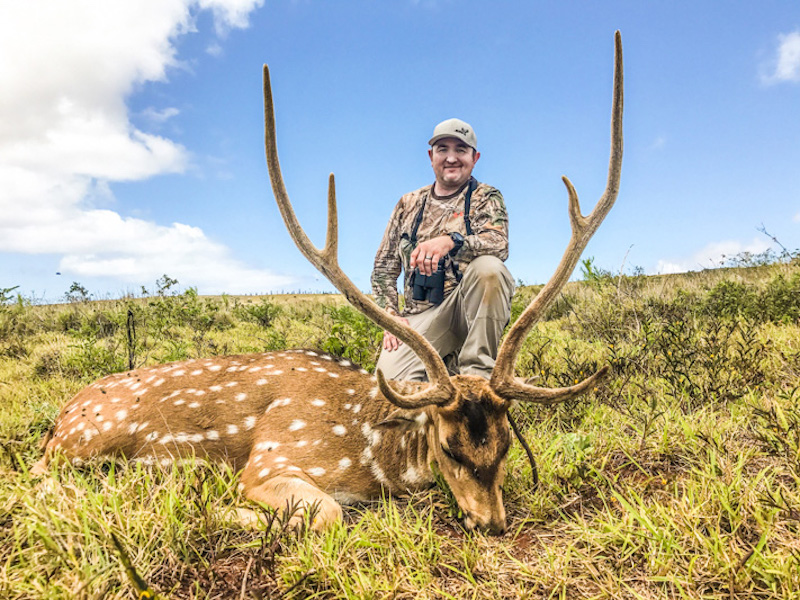In many areas across whitetail country, bow season is still open. But the magic of the rut is over. And an orange army of gun hunters has taken a heavy toll on the deer population. Oh, there are still deer to hunt. But now they’re skittish, after months of hunting pressure. And to hunt them, you’ll have to endure cold temperatures and perhaps deep snow.
If hunting in these conditions sounds less than appealing, why not shake it up a little and head south? Plenty of bowhunting options exist, and you won’t have to freeze to experience them.

Check out Tampa Bay for bowfishing opportunities. Photo Credit: FishingBooker
You never have to look too hard to find a reason to visit the Sunshine State. Florida offers a multitude of winter bowhunting opportunities, including wild hogs and inland bowfishing. But one option that’s really popular with locals and tourists alike is the opportunity to bowfish in saltwater. Bowfishers have a wide variety of species at their disposal, includingmullet, cobia, drum, snappers, flounder and even some variety of rays. Most bowfishing takes place at night from lighted boats, but daytime trips are also an option. If you are already adept at bowfishing for carp, gar and other freshwater species, saltwater bowfishing is a new twist. Even if you’ve never tried bowfishing, experienced guides can have you shooting proficiently in just one trip.
Chasing wild hogs is another excellent way to extend your archery season. In many areas of the South, hogs are thriving and pursuing them is extremely popular. In some areas, particularly on private land, hog hunting is open year-round.
Your whitetail archery setup will be just fine for hog hunting, but be warned: wild hogs are tough hombres. The vital area on a hog – particularly a young one – is smaller than a deer’s vital area. To keep your arrow groups tight, you’ll need constant practice.. There’s little room for error on wild hogs. Their muscles and shoulder blades are seemingly armor-plated.
Whether you hunt hogs over feeders or over natural food sources such as acorns, they’re a great challenge. They’re wary, often preferring to wait until after the cover of darkness to feed, especially when pressured. Hogs also have an excellent sense of smell, so you’ll have to exercise the same scent-control regimen you use on deer. But they can be excellent on the table, and they’re a worthy challenge. Hog hunting is the perfect remedy for bowhunters lamenting the off-season.

South Texas remains reasonably warm during the winter and offers impressive deer. Photo Credit: Four Seasons Ranch
South Texas is legendary for its whitetail hunting. Although whitetail body size is relatively small, bucks grow some downright impressive racks in the brush country. Bowhunters in South Texas often have thousands of acres of land at their disposal when hunting the area’s numerous ranches. Deer hunting is king here, and ranches maintain feed stations and water tanks for the region’s whitetails, as well as hogs, exotics, turkeys and other wildlife species.
Not only can bowhunters take some truly world-class bucks in South Texas,they may also hunt the rut long after peak breeding has ended in many areas of the country. The bulk of rutting activity in South Texas happens in mid- to late December, although breeding may continue into February.
In addition to whitetails, ranches may offer combination hunts that include chances at wild hogs, javelinas, turkeys, predators and even exotics such as fallow deer.
Perhaps one of bowhunting’s greatest challenges is the diminutive Coues deer. This tiny whitetail subspecies inhabits Arizona, New Mexico and Mexico. A mature buck might only weigh 100 pounds on the hoof, and an 8-point rack is a trophy.
But what this tiny deer lacks in size, it makes up for in elusiveness. Coues deer are at home in rugged, arid terrain, ranging from 2,500 feet above sea level to 10,000 feet. During the heat of the day they often bed in thick cover. These “gray ghosts” blend perfectly with their environs. It takes a keen eye and great optics to spot a bedded buck. As difficult as it is to find one, merely observing one pales in comparison to creeping across rugged terrain to get within bow range of these tiny, yet wary, deer.
Fortunately for bowhunters, archery tags are available over the counter in Arizona. Coues deer rut primarily in January, so you can fulfill your holiday obligations – and then try to fill your Coues tag. It won’t be easy, but it’ll sure be fun.

Hop over to Hawaii to bowhunt axis deer. Photo Credit: High Adventure Company
When most people think of Hawaii, images of beaches and surfing come to mind. But for some, a vacation just wouldn’t be a vacation without some hunting opportunities. Although it might fly under the radar, Hawaii has some surprisingly good hunting for exotics.
Some islands – Lanai in particular – have incredible axis deer populations. You may see dozens, perhaps even hundreds, of deer per day. These deer with spotted-fawn coloration grow some impressive antlers. They make remarkable, memorable trophies.
Sheep and goats are also present. You can hunt Mouflon sheep, either purebred or hybrid.. These animals inhabit the high country and present a real challenge for spot-and-stalk bowhunters.
Black Hawaiian sheep and Spanish goats were brought to Hawaii in the 1700s. These species frequent rocky cliffs at high elevations.
If you’re looking for an affordable “cape buffalo” hunt, you might try pursuing Hawaii’s Vancouver bulls. No, these wild bulls aren’t actually cape buffalo, but the 1,000-pound animals are extremely dangerous, especially when wounded. They’re guaranteed to get your heart pounding.
Hawaii also offers turkeys, wild boar and other species. Sure beats a day at the beach!